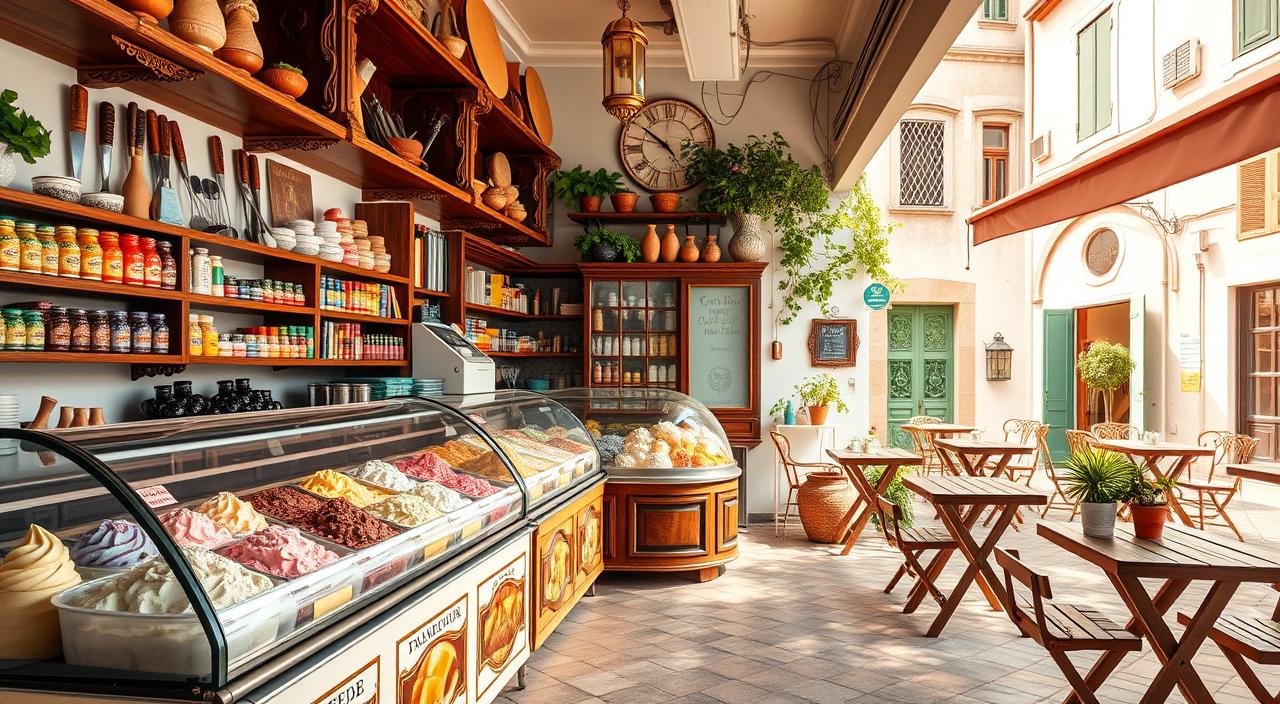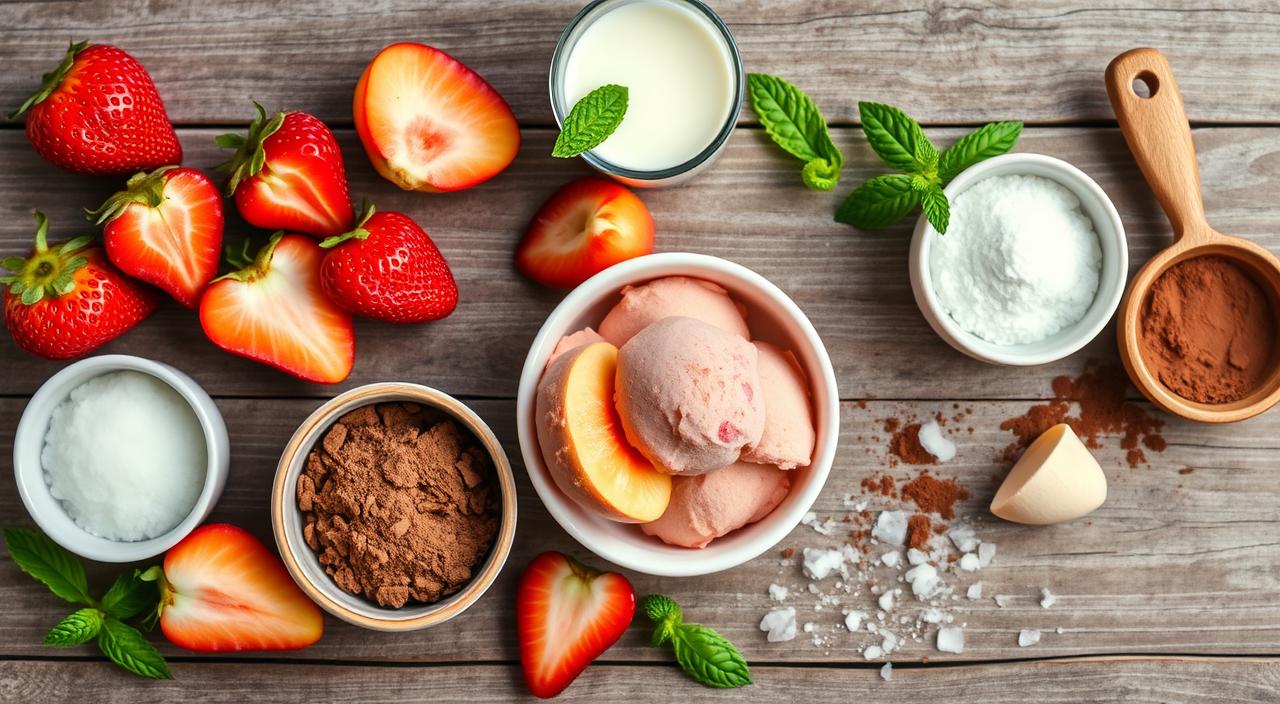The Origin of Ice Cream: A Journey Through Time
The history of ice cream is a fascinating story that spans centuries and continents. It starts with ancient civilizations in Persia and China. Then, it moves to 17th-century Italy, where cream-based ice cream was first made.
This treat has become a favorite around the world. It went from a luxury for the rich to something everyone loves. It shows how food brings us together, connecting us to our past, present, and future.
The story of ice cream begins in the second century B.C. Ancient cultures in Persia and China made frozen treats from snow, ice, and flavors. These early versions were a luxury for the rich, as making them was hard and expensive.
Ancient Beginnings: The Frozen Delights of Antiquity
The history of ice cream goes back to ancient Persia, Rome, and China. These places enjoyed frozen treats over 2,500 years ago. In Persia, people made “bastani” by mixing grape juice, fruit, and ice.
In ancient Rome, they had “granita,” made by shaving ice and adding fruit juices and honey. China’s royal court enjoyed a frozen mix of milk, rice, and snow since 200 BCE.
The Persians and the Earliest Known Ice Cream
In Persia (Iran) around 500 BC, they created “bastani.” It was a frozen dessert made with grape juice, fruit, and ice. This treat was loved by the elite and seen as a luxury.
Ancient Roman and Chinese Icy Desserts
In Rome, “granita” was made by shaving ice and mixing it with fruit juices and honey. China’s royal court enjoyed a frozen mix of milk, rice, and snow since 200 BCE. This was before modern ice cream was made.
| Civilization | Frozen Dessert | Ingredients | Era |
|---|---|---|---|
| Persia | Bastani | Grape juice, fruit, and other sweet flavors mixed with ice | 500 BC |
| Ancient Rome | Granita | Shaved ice, fruit juices, and honey | Unknown |
| Ancient China | Frozen Milk-Rice Mixture | Milk, rice, and snow | 200 BCE |
These ancient civilizations started the journey of frozen desserts. They paved the way for the ice cream we enjoy today.
The Origin of Ice Cream: A Journey Through Time
Marco Polo’s Influence on Italian Ice Cream
Cold desserts arrived in Europe during the Middle Ages. Recipes for icy drinks and frozen treats showed up in cookbooks. The creamy ice cream we know today started in 17th-century Italy, loved by the nobility.
The famous explorer Marco Polo brought Chinese recipes to Italy in the 13th century. These recipes likely helped create the smooth “gelato” style of ice cream.
The Evolution of Ice Cream in Europe
Italy’s love for ice cream spread to France and England. By the 18th century, ice cream was enjoyed by everyone, not just royals. The 19th century saw the invention of the hand-cranked ice cream machine, making it even more accessible.
African American confectioners in the 19th century added new flavors and techniques. The 1930s brought soft serve ice cream, changing how we enjoy it.
Now, the ice cream industry offers healthier options like low-fat and non-dairy. Flavors have also grown, from classics to exotic ones. This shows how ice cream remains a favorite, adapting to our changing tastes.
Ice Cream Arrives in America: A Sweet Revolution
The history of ice cream in America is filled with innovation and making it accessible to all. It first came to the American colonies in the 17th century, enjoyed by the wealthy. But, the hand-cranked ice cream maker in the mid-19th century changed everything. It let families make their own ice cream at home.
Thomas Jefferson, the third President, played a big role in American ice cream history. He loved fine food and even made his own vanilla ice cream recipe. This recipe, along with Nancy Johnson’s ice cream freezer in 1843, made ice cream more common. It went from a luxury to a treat for everyone.
As the 19th century went on, ice cream parlors started to appear everywhere. They offered many flavors and toppings. These places became places where people came to enjoy ice cream and each other’s company. The ice cream cone, invented at the 1904 St. Louis World’s Fair, made ice cream even more popular and easy to eat on the go.
The story of ice cream in America shows the nation’s creativity and drive. From Thomas Jefferson’s recipe to the changes brought by new technology, ice cream has become a big part of American life. It brings happiness and brings people together.
| Year | Event |
|---|---|
| 1843 | Nancy Johnson patents the first hand-cranked ice cream freezer, revolutionizing home ice cream production. |
| 1790 | The first ice cream parlor opens in New York City, marking the beginnings of the ice cream industry in America. |
| 1904 | The invention of the ice cream cone at the St. Louis World’s Fair further popularizes the treat. |
| 1922 | The first ice cream bar, the “I-Scream-Bar,” is patented in the US by Christian Kent Nelson. |
The Modern Era: Innovation and Global Expansion
The 20th century saw a big leap in ice cream innovation. New flavors, toppings, and technologies emerged. The electric ice cream maker, invented in the 1930s, changed the game. It made making ice cream easier and helped it become more popular.
Technological Advancements and Mass Production
Automated manufacturing and refrigeration spread fast. This let ice cream industry pioneers share their creations with more people. Ice cream became a favorite treat globally.
Ice Cream Innovations: From Cones to Sandwiches
The early 20th century brought big changes to ice cream. The ice cream cone, introduced at the 1904 St. Louis World’s Fair, changed how we enjoy ice cream. Then, the ice cream sandwich came along, making it easy to take ice cream on the go.
Today, the global ice cream industry keeps growing. It offers many flavors and ways to enjoy ice cream. From classic scoops to ice cream cones and sandwiches, it’s clear ice cream is here to stay.
| Innovation | Year | Impact |
|---|---|---|
| Electric Ice Cream Maker | 1930s | Revolutionized mass production and made ice cream more accessible |
| Ice Cream Cone | 1904 | Popularized at the St. Louis World’s Fair, providing a convenient way to enjoy ice cream |
| Ice Cream Sandwich | Early 20th Century | Offered a portable and convenient ice cream treat |
“The ice cream industry’s ability to adapt and innovate has firmly cemented its place as a beloved and enduring part of global cuisine.”
Conclusion: Ice Cream’s Enduring Legacy
Ice cream’s journey through time shows its lasting charm and cultural importance. It started in ancient times and now is loved worldwide. Its growth shows our love for treats, creativity, and sharing moments.
The story of ice cream’s cultural significance shows it’s more than just a dessert. It brings joy, comfort, and connects people. Whether it’s a cool treat on a hot day or a highlight at parties, ice cream makes memories.
The history of ice cream shows how it went from a luxury to something everyone enjoys. This change shows how society, technology, and our views on food have evolved. Ice cream now is a symbol of happiness and togetherness.
Today, ice cream’s global popularity proves its timeless appeal. It offers both classic and new flavors, pleasing everyone. Enjoying ice cream is a way to honor its rich history and cultural role in our lives.
FAQ
What are the origins of ice cream?
The earliest ice cream-like treats come from ancient Persia, Rome, and China. These civilizations enjoyed frozen desserts made with fruit, honey, and milk. Only the elite could afford these treats.
How did ice cream evolve in Europe?
Italy is where cream-based ice cream was first made in the 17th century. It quickly became a favorite among the nobility. Marco Polo brought Chinese recipes to Italy, which helped create the smooth “gelato” ice cream.
Ice cream’s popularity grew across Europe. France and England played big roles in making it more accessible to everyone.
When did ice cream arrive in America?
Ice cream came to America in the 17th century. It quickly became a favorite treat. By the 19th century, ice cream parlors were everywhere, offering many flavors and toppings.
The invention of the hand-cranked ice cream maker in the mid-19th century let families make their own ice cream. This helped the industry grow even more.
What were some key innovations in the 20th century?
The 20th century was a time of big changes in ice cream. New flavors, toppings, and technologies emerged. The electric ice cream maker, introduced in the 1930s, made making ice cream easier and more popular.
The ice cream cone, introduced at the 1904 St. Louis World’s Fair, and the ice cream sandwich were also big hits.
How has ice cream become a global phenomenon?
Today, ice cream is loved all over the world. It’s a huge industry with billions of dollars in sales. There are countless flavors and varieties for everyone.
The story of ice cream shows how creativity, innovation, and the love for treats bring people together. It connects us to our past, present, and future through food.


